Steel tubing is a fundamental component within the oil and gas industry, serving a multitude of critical functions across various operational domains. From the transportation of fluids to supporting infrastructure in offshore production systems, the significance of steel tubing cannot be overstated.
Understanding the nuanced specifications, material choices, and industry standards is pivotal in ensuring seamless and efficient operations. The complexities and nuances of steel tubing in this context represent a vital aspect that warrants a closer examination, shedding light on the indispensable role it plays in the oil and gas sector.
Key Takeaways
- Steel tubing is commonly used in the oil and gas industry for various applications such as fluid transportation, conveyor belt rollers, bearing casings, and concrete pilings.
- Tubing is subject to strict specifications and regular testing for properties like hardness and tensile strength.
- The precise outside diameter of tubes indicates their weight-bearing capacity.
- Tubes are generally more expensive than pipes due to the materials used, and their cost can vary based on the specific end-user requirements.
what is steel tubing for oil and gas
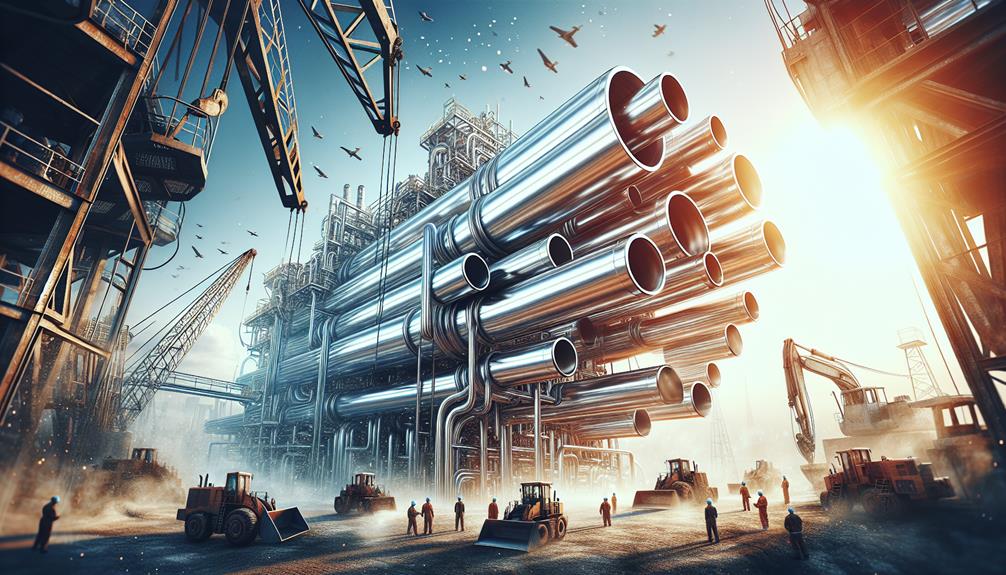
Steel tubing for oil and gas serves as a critical component in the extraction, transportation, and processing of petroleum and natural gas resources. When it comes to material selection for steel tubing, corrosion resistance is of utmost importance, especially in offshore applications.
The choice of steel and its composition play a vital role in ensuring the longevity and integrity of the pipeline. Welding techniques used in the fabrication of steel tubing are crucial for maintaining the structural strength and integrity of the pipes.
Offshore applications, in particular, demand robust and durable steel tubing that can withstand harsh environmental conditions, including saltwater exposure and extreme pressures. Therefore, innovative approaches to enhancing corrosion resistance, such as advanced coatings and material compositions, are continually sought after in the development of steel tubing for oil and gas.
Additionally, advancements in welding techniques and technology contribute to ensuring the reliability and performance of steel tubing in demanding offshore environments, where pipeline integrity is paramount for safe and efficient operations.
Pipes and Tubing for Oil and Gas: What is the Difference?
Pipes and tubing are essential components in the oil and gas industry. Each serves specific purposes and understanding the differences between them is crucial for their appropriate application.
Key factors including material, cost, and dimensional tolerances differentiate pipes and tubing. These factors are critical in determining their suitability for various oil and gas operations.
Pipe basics
The distinction between pipes and tubes in the context of oil and gas applications lies in their specific characteristics and applications within the industry.
When it comes to steel tubing manufacturing, various corrosion prevention methods are crucial, especially for tubing used in offshore applications, subsea pipelines, and refinery operations.
Understanding the differences between pipes and tubes is essential for effective selection and utilization in oil and gas operations. Here are some key aspects to consider:
- Material composition and cost-effectiveness
- Tolerances and measurements
- Specific applications and usage
- Standards and specifications
Each of these factors plays a critical role in ensuring the optimal performance and longevity of the tubing or piping systems used in oil and gas operations.
Tube basics
Utilizing various corrosion prevention methods is crucial in the manufacturing of steel tubing for oil and gas applications. This is particularly important in offshore and subsea pipeline operations and refinery activities. Material selection is a critical aspect, with considerations for corrosion resistance, strength, and durability.
The tube manufacturing process involves precision engineering to meet stringent industry standards. This ensures reliable performance in demanding offshore drilling environments. Tube inspection methods, such as ultrasonic testing and electromagnetic inspection, are employed to guarantee structural integrity and corrosion resistance.
Steel tubing finds extensive applications in offshore drilling, providing reliable fluid transportation and structural support. Innovative techniques in corrosion prevention, advanced material selection, and rigorous inspection processes are fundamental in meeting the challenges of offshore and subsea operations. These methods ensure the safety and efficiency of oil and gas infrastructure.
Common Oil & Gas Applications
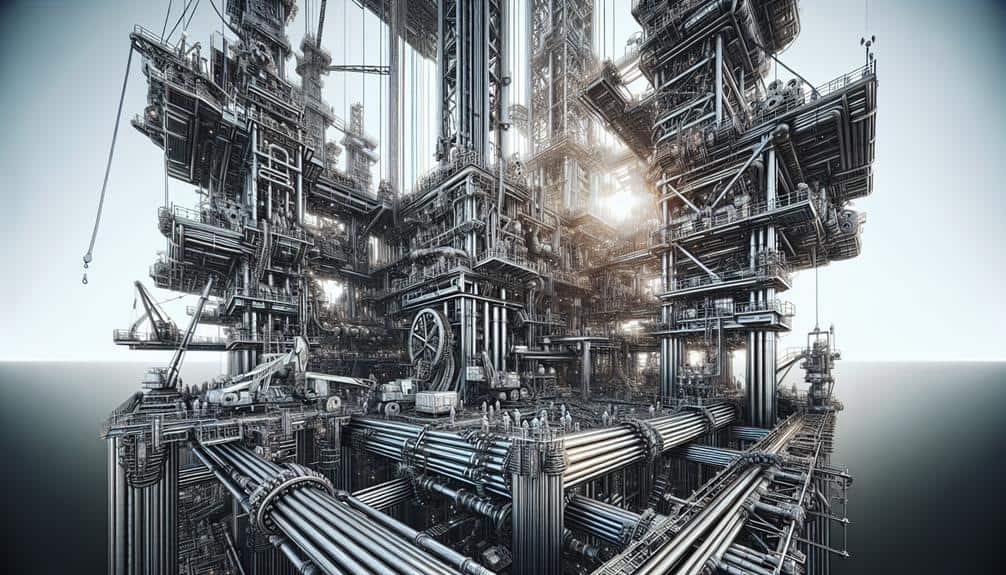
Common oil and gas applications encompass a wide range of uses for steel tubing. These applications include:
- The use of drill pipes for creating boreholes and allowing drilling fluid circulation.
- Production tubing for extracting oil or gas from reservoirs and transporting them to the surface.
- Transmission pipelines that transport crude oil, natural gas, and refined products over long distances.
Additionally, other components such as distribution pipelines, distillation columns, cracking units, and storage tanks are integral in the refining and processing stages of oil and gas operations.
drill pipes
Drill pipes are integral components within the oil and gas industry, facilitating the process of creating boreholes and enabling the circulation of drilling fluid.
Key Aspects of Drill Pipes:
Manufacturing Precision: Drill pipes are manufactured with stringent quality control measures to ensure reliability in demanding drilling environments.
Corrosion Prevention: Innovative coatings and materials are employed to protect drill pipes from corrosion and extend their operational lifespan.
Inspection Techniques: Advanced inspection methods such as electromagnetic inspection and ultrasonic testing are used to maintain the integrity of drill pipes.
Tubing Connections: The development of robust and efficient connections between drill pipes is crucial for seamless drilling operations.
Drill pipes play a pivotal role in the exploration and extraction of oil and gas, driving continuous advancements in their design, materials, and operational capabilities.
production tubing or casing
Production tubing and casing are essential components in the oil and gas industry, facilitating the extraction and transportation of oil and gas from reservoirs to the surface. The table below outlines the specifications for casing and tubing, as well as the standards for line pipes.
| Specifications for Casing and Tubing | Standards for Line Pipes | Advantages of Steel Pipes |
|---|---|---|
| – API 5CT – BS EN ISO 11960 – NF M87-207 – JIS G3439 – Grades: H40, J55, K55, N80, C75, L80, C90, T95, Q125, and more. | – API SPEC 5L – GB/T9711 – PSL1 grades: A/L210, B/L245, X42/L290, X46/L320, X52/L360, X56/L390, X60/L415, X65/L450, X70/L485 – PSL2 grades: L245N/Q, L290R/N/Q, L320N/Q, L360N/Q, L390N/Q, L415N/Q, L450N/Q, L485N/Q | – Advanced heating and cooling system – Two Siemens electronic-controlled six roll straightening machines – Two production specifications: Outer diameter of 114 mm to 406 mm and length up to 13.5 m, or outer diameter of 48 mm to 180 mm and length up to 12.5 m – Annual production: 150,000 tons of |
These specifications and standards ensure the reliability and efficiency of lubricant transportation, offshore pipelines, and the overall performance of steel tubing in the oil and gas industry.
transmission pipelines
In the oil and gas industry, the transportation of crude oil, natural gas, and refined products over long distances is facilitated through the utilization of transmission pipelines.
Corrosion prevention techniques are crucial for ensuring the longevity and efficiency of transmission pipelines.
Advanced pipeline construction methods, such as horizontal directional drilling, enhance the installation process and minimize environmental impact.
Offshore drilling demands specialized transmission pipeline designs to withstand harsh marine conditions and deep-sea pressures.
Regular pipeline maintenance and inspection using advanced technologies, including smart pigs and drones, are essential for ensuring operational safety and integrity.
Distribution pipelines
The distribution of crude oil, natural gas, and refined products to end users is a critical aspect of the oil and gas industry. It requires a comprehensive network of distribution pipelines. Pipeline construction for distribution networks demands high-quality materials and precise engineering to ensure efficient and safe transportation.
Pipeline maintenance and inspection are vital to uphold the integrity of the distribution pipeline system. This helps prevent leaks and ensures continuous supply. Safety measures in distribution pipelines are paramount. They necessitate advanced technologies and rigorous protocols to monitor and mitigate potential risks.
Innovation in distribution pipeline design and operation plays a crucial role in optimizing the efficiency and reliability of oil and gas delivery to end users.
distillation columns, cracking units, and storage tanks
Distillation columns, cracking units, and storage tanks are integral components of the infrastructure in oil and gas processing facilities. They play crucial roles in the separation, refining, and storage of hydrocarbons.
Corrosion Resistance: Seamless tubing used in these components ensures durability and longevity in corrosive environments.
Efficient Separation: Distillation columns facilitate the separation of crude oil into various components based on their boiling points.
Cracking Units: These units are utilized for the thermal or catalytic conversion of heavy hydrocarbons into lighter, more valuable products such as gasoline and diesel.
Storage Tanks: Storage tanks are essential for storing crude oil, natural gas, and refined products before they are transported to end users.
These components require materials that can withstand harsh conditions. Therefore, corrosion-resistant seamless tubing is a fundamental choice for ensuring the integrity and functionality of distillation columns, cracking units, and storage tanks in oil and gas processing.
Injection wells
Injection wells play a critical role in the oil and gas industry, serving as a key component in the process of enhancing hydrocarbon recovery from reservoirs. These wells are crucial for the injection of fluids, such as water, gases, or chemicals, into the subsurface for various purposes.
Corrosion resistance is paramount, especially in offshore applications, to ensure the longevity and reliability of the injection well tubing. Therefore, tubing specifications must adhere to stringent standards to withstand harsh offshore environments.
Additionally, innovative drilling techniques are employed to create and maintain these wells, optimizing their efficiency and performance.
subsea production systems, pipelines, and risers
With a focus on offshore applications, the design and construction of subsea production systems, pipelines, and risers in the oil and gas industry demand meticulous attention to detail and a constant pursuit of technological advancements to meet the evolving needs of the industry, ensuring corrosion resistance and adherence to stringent standards for longevity and reliability.
Subsea Installation: Specialized techniques for installing and maintaining subsea equipment in offshore environments.
Corrosion Resistance: Utilization of corrosion-resistant materials to withstand harsh subsea conditions and ensure long-term performance.
Offshore Transportation: Efficient and reliable methods for transporting oil and gas from offshore facilities to onshore or floating storage units.
Pipe Materials and Riser Design: Selection of appropriate materials for subsea pipelines and the intricate design of risers for connecting subsea production systems to floating platforms or onshore facilities.
Upstream
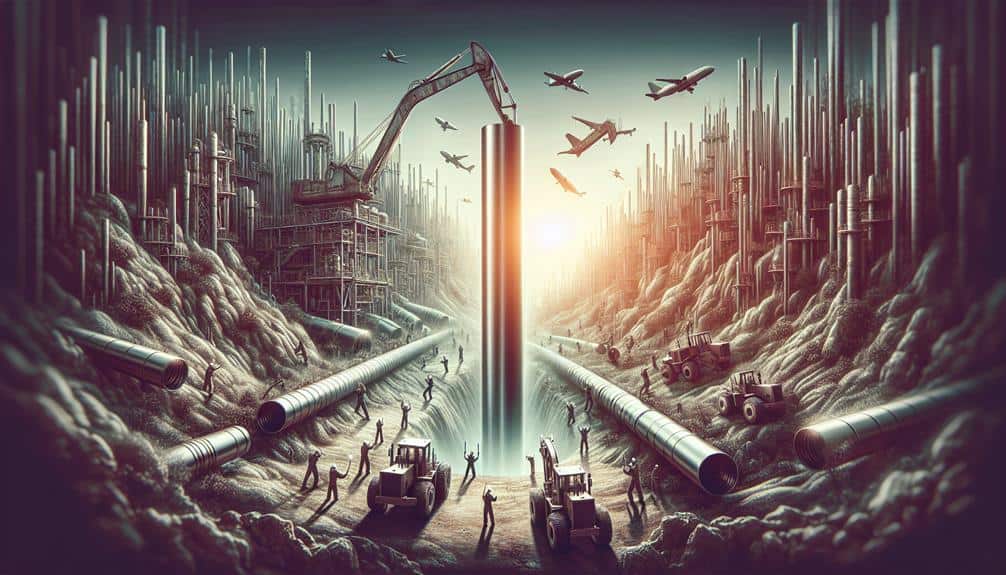
Upstream activities in the oil and gas industry encompass the exploration, drilling, and infrastructure development necessary for the extraction and transportation of hydrocarbon resources. Within offshore applications, steel tubing plays a critical role in enabling these activities.
Steel pipes offer several advantages, including corrosion resistance and high tensile strength, making them ideal for the harsh offshore environment. Tubing specifications, such as API 5CT and BS EN ISO 11960, ensure that steel tubes meet the stringent requirements for use in petroleum and natural gas industries.
The steel tubing manufacturing process involves advanced heating and cooling systems to ensure precise dimensions and properties. Additionally, the use of electronic-controlled straightening machines guarantees the straightness of seamless steel pipes, which is essential for their performance in upstream activities.
With the capability to produce various specifications and sizes, these steel tubes are crucial components for drilling, extraction, and infrastructure development in the upstream sector of the oil and gas industry.
Midstream
Steel tubing plays a crucial role in the midstream sector of the oil and gas industry, particularly in gathering and transportation activities. This pivotal role involves the utilization of innovative technologies and strategies to ensure efficient and safe operations.
Here are four key aspects of the midstream sector:
Corrosion Prevention: Implementing advanced coating technologies and corrosion-resistant materials to protect pipelines and offshore infrastructure from deterioration, ensuring longevity and reliability.
Pipeline Maintenance: Utilizing cutting-edge inspection and maintenance techniques to uphold the integrity and functionality of the extensive network of pipelines, enhancing operational safety and efficiency.
Offshore Infrastructure: Developing and maintaining robust infrastructure for offshore oil and gas activities, including pipelines, platforms, and subsea systems, to support storage and transportation operations.
Storage and Transportation: Employing state-of-the-art storage facilities and logistical solutions for the safe and efficient transportation of oil, gas, and natural gas liquids, ensuring a seamless flow within the midstream segment.
The midstream sector plays a critical role in the oil and gas industry, and its continuous innovation in corrosion prevention, pipeline maintenance, offshore infrastructure, and storage and transportation is essential for ensuring pipeline safety and operational excellence.
Downstream
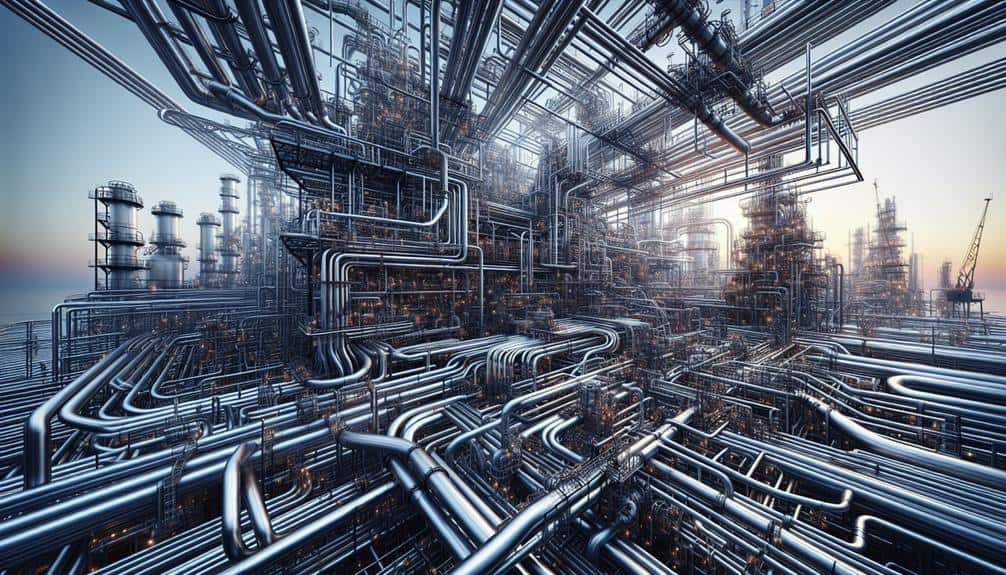
The downstream sector of the oil and gas industry encompasses the refining, distribution, marketing, and storage of petroleum products, playing a crucial role in ensuring the efficient delivery of refined products to end consumers.
In downstream operations, the refining process is a critical stage where crude oil is converted into valuable products such as gasoline, diesel, and lubricants.
Storage facilities are essential for holding refined products before distribution, with a focus on maintaining product integrity and safety.
Pipeline maintenance is vital to ensure the seamless transportation of refined products to various locations, including offshore installations.
Offshore applications in the downstream sector involve the use of subsea production systems, transportation of oil and gas from offshore facilities, and the implementation of corrosion-resistant materials for pipes in challenging offshore environments.
Types of tubes and pipes used for oil and gas
When considering the types of tubes and pipes used for oil and gas applications, it is essential to examine the API tubing standard and the ISO tubing standard. These standards play a crucial role in ensuring the quality and performance of tubing and casing in the petroleum and natural gas industries.
Understanding the specifications outlined in these standards is fundamental for selecting the most suitable tubes and pipes for various oil and gas operations.
API tubing standard
API tubing standard specifies the types of tubes and pipes used for oil and gas, outlining specific requirements for design, testing, and manufacture.
Key Points:
Tubing Grade Selection: API grades are organized into three groups, with each grade offering unique mechanical properties and chemical content.
Tubing Manufacturing Processes: Tubing can be manufactured using seamless or electric-weld processes, each with its own characteristics and considerations.
Tubing Heat Treatment: Heat treatment processes are crucial to eliminate any potential defects and ensure the desired mechanical properties of the tubing.
Tubing Yield Strength: API defines yield strength as the tensile stress required to produce a specific total elongation per unit length on a standard test specimen.
In essence, adherence to API tubing specifications is fundamental for ensuring the quality and performance of tubing used in oil and gas applications.
ISO tubing standard
Adhering to stringent standards in the oil and gas industry is fundamental for ensuring the quality, safety, and performance of pipeline systems, with the ISO 13623:2009 providing comprehensive guidelines for the design, materials, construction, testing, operation, maintenance, and abandonment of tubing and pipeline systems. The ISO tubing standard ensures that rigid, metallic pipelines meet functional requirements, and it does not apply to flexible pipelines or those constructed from other materials, such as glass-reinforced plastics. This standard is applicable to all new pipeline systems and can be applied to modifications made to existing ones, providing a basis for their safe design, construction, testing, operation, maintenance, and abandonment. The table below highlights the properties, manufacturing process, corrosion resistance, and benefits of using steel tubing, along with the inspection and testing procedures.
| Steel Tubing Properties | Manufacturing Process | Corrosion Resistance |
|---|---|---|
| High strength and durability | Seamless or welded | Resistant to corrosion and oxidation |
| Excellent ductility and toughness | Cold drawing or hot-finished | Protection against harsh environments |
| Precise dimensions and tolerances | Heat treatment processes | Longevity and low maintenance |
This table provides a concise overview of the advantages of using steel tubing in the oil and gas industry, emphasizing its robust properties, manufacturing techniques, and corrosion-resistant nature.
Examples of steel tubes used in oil and gas
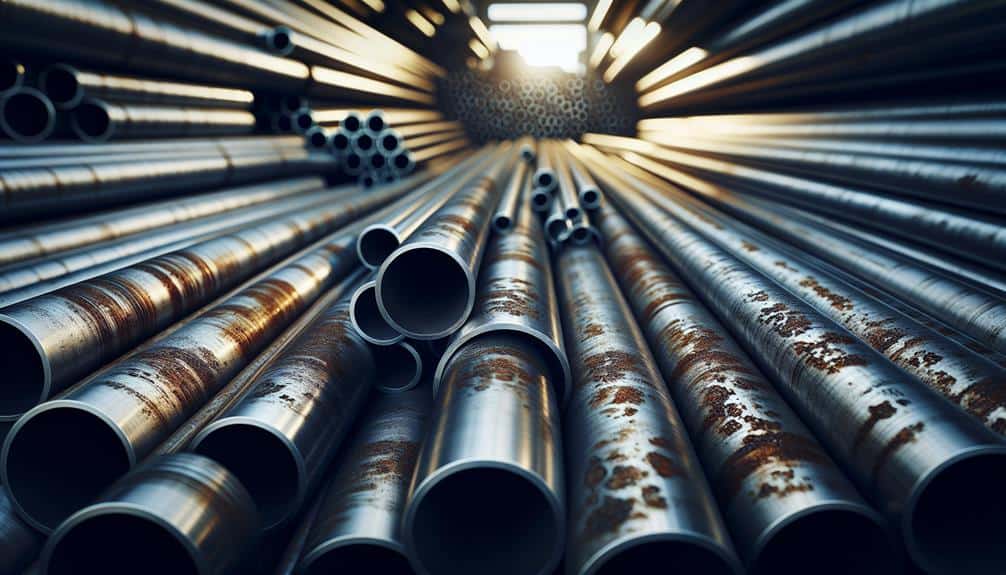
Steel tubes used in oil and gas applications include:
- API 5CT casing and tubing
- BS EN ISO 11960
- NF M87-207
- JIS G3439
- API SPEC 5L
These tubes are essential for various purposes such as:
- Supporting the walls of oil and gas wells
- Transporting resources
- Serving as drill pipes
Each standard and grade plays a crucial role in ensuring the integrity and efficiency of oil and gas operations.
API 5CT: casing and tubing
Casing and tubing play crucial roles in the oil and gas industry, serving as integral components for the extraction, transportation, and storage of petroleum resources.
Steel Tubing Manufacturing: Pipes are manufactured in seamless or EW types, with seamless couplings and coupling materials.
Casing and Tubing Specifications: API 5CT establishes requirements for product specification levels and common grades, such as J55/K55 and N80/N80Q/L80.
Heat Treatment of Casing and Tubing: Different heat treatment methods are applied for each grade, with full body and full-length heat treatment required for products needing heat treatment.
Threading and Gauging Practices: Threading and gauging practices should comply with API Spec 5B, with product ends required to be free of burrs.
These critical aspects ensure the reliability and efficiency of casing and tubing in the oil and gas sector.
BS EN ISO 11960
Enhancing the understanding of BS EN ISO 11960 standards is essential in comprehending the diverse applications and specifications of steel tubes utilized within the oil and gas industry. The following table provides an overview of the key aspects related to steel tubing applications, corrosion resistance, manufacturing process, industry standards, inspection, and testing.
| Aspect | Description |
|---|---|
| Steel tubing applications | Used in drilling, production, transportation, gathering, and refining |
| Corrosion resistance | Utilization of corrosion-resistant materials for prolonged durability |
| Manufacturing process | Seamless or welded production methods to meet specific industry needs |
| Industry standards | Compliance with API 5CT, BS EN ISO 11960, NF M87-207, and JIS G3439 |
| Inspection and testing | Stringent testing for hardness, tensile strength, and dimensional accuracy |
This concise breakdown offers insights into the pivotal features of steel tubing within the oil and gas sector, ensuring adherence to rigorous industry standards and optimal performance.
NF M87-207
Manufacturers adhere to NF M87-207 standards to ensure the quality and suitability of steel tubes for various applications within the oil and gas industry.
The NF M87-207 standard outlines the specific requirements for steel tubes used in casing or tubing within the petroleum and gas sectors. Here are key aspects related to NF M87-207:
Corrosion resistance: NF M87-207 specifies the necessary corrosion resistance properties for steel tubes used in challenging oil and gas environments.
Steel tubing specifications: The standard provides detailed specifications for the manufacturing processes, dimensions, and material properties of steel tubes.
Oil and gas industry compliance: NF M87-207 ensures that steel tubes meet the stringent requirements of the oil and gas industry, including durability and performance in demanding conditions.
Manufacturing processes: The standard outlines the manufacturing processes that guarantee the reliability and integrity of steel tubing used in oil and gas applications.
JIS G3439
The JIS G3439 standard, a Japanese Industrial Standards (JIS) specification, encompasses seamless steel oil well, casing, tubing, and drill pipe and plays a crucial role in defining the quality and characteristics of steel tubes utilized in the oil and gas industry. This standard ensures that the steel tubes used in oil and gas applications meet specific requirements for corrosion resistance, mechanical properties, welding techniques, heat treatment, and manufacturing processes. The table below provides an overview of the grades included in the JIS G3439 standard:
| Grade | Description | Characteristics |
|---|---|---|
| STO-G | General grade | Moderate properties |
| STO-H | High-strength grade | Enhanced mechanical strength |
| STO-J | Impact-resistant grade | Improved toughness |
| STO-N | Corrosion-resistant grade | High resistance to corrosion |
| STO-C | Coupling stock grade | Designed for pipe coupling manufacturing |
These grades are designed to meet the diverse needs of the oil and gas industry, ensuring the reliability and performance of steel tubing in various operational environments.
API SPEC 5L
API SPEC 5L is an international standard that governs the manufacture of seamless and welded steel pipes. It is essential for ensuring the quality and performance of pipes used in pipeline transportation systems for the petroleum and natural gas industries.
Key Points:
API 5L Specifications: API 5L provides technical updates and includes two product specification levels (PSL 1 and PSL 2).
Seamless vs Welded Pipes: The standard covers both seamless and welded steel pipes, catering to different application requirements.
Corrosion Resistance of Steel Tubing: API 5L specifies requirements for corrosion-resistant pipes, crucial for durability in harsh environments.
Transportation and Storage of Steel Tubing: The standard ensures that steel tubing is manufactured to withstand the rigors of transportation and storage, maintaining structural integrity and performance.
API SPEC 5L plays a critical role in the manufacturing and deployment of steel tubing for the oil and gas industry. It drives innovation and reliability in pipeline systems.
GB/T9711
Examples of steel tubes used in oil and gas can be found in the GB/T9711 standard. This Chinese standard specifies the requirements for the manufacture of seamless and welded steel pipes for pipeline transportation systems in the petroleum and natural gas industries. The GB/T9711 standard is crucial for ensuring the quality and performance of steel tubes used for low pressure liquid delivery, such as water, gas, and oil.
The GB/T9711 standard incorporates redrafting methods and adopts ISO 3183.2007 (second edition). This alignment with international best practices ensures that the manufacturing and inspection processes adhere to industry standards. By adhering to these standards, the industry can maintain the integrity of pipeline transportation systems, ensuring the safe and efficient delivery of vital resources.
Frequently Asked Questions
What Are the Specifications and Standards for Steel Tubing Used in Oil and Gas Applications?
In the realm of industry standards, steel tubing specifications for oil and gas applications are defined by quality certification and material advantages, impacting projects through advanced heating and cooling systems and strict standards compliance.
How Are Steel Tubes Used in Offshore Oil and Gas Applications Different From Those Used Onshore?
Offshore steel tubes require higher corrosion resistance and material strength due to harsh marine environments, while onshore tubes prioritize cost-effectiveness and ease of welding techniques. Both must consider environmental impact and adherence to industry standards.
What Are the Advantages of Using Steel Tubing Over Other Materials for Oil and Gas Transportation?
Steel tubing offers myriad advantages for oil and gas transportation, including durability, corrosion resistance, and cost-effectiveness. Its ability to withstand high pressure makes it a preferred choice, ensuring reliable and efficient operations.
How Is Steel Tubing for Oil and Gas Production Tested and Certified for Quality and Safety?
Steel tubing for oil and gas production undergoes rigorous testing methods and certification processes to ensure compliance with safety standards and quality assurance. Material specifications are meticulously reviewed to guarantee optimal performance and reliability.
Can You Provide Examples of Specific Projects or Installations Where Steel Tubing Has Been Used in the Oil and Gas Industry, and the Impact It Has Had on Operations?
In pipeline construction, steel tubing has improved efficiency through its robustness and reliability. In well drilling, it enhances operations with great durability. Refinery infrastructure benefits from its performance, and offshore platforms leverage its resilience for safe and efficient operations.
Conclusion
In conclusion, steel tubing is an essential component in the oil and gas industry, with diverse applications in upstream, midstream, and downstream activities.
The precise specifications and material choices directly impact operational efficiency and safety, making it crucial for successful deployment.
The use of steel tubing facilitates the extraction, transportation, and processing of oil and gas resources, serving as a critical link in the industry’s supply chain.


